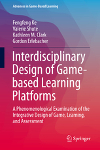- About MAA
- Membership
- MAA Publications
- Periodicals
- Blogs
- MAA Book Series
- MAA Press (an imprint of the AMS)
- MAA Notes
- MAA Reviews
- Mathematical Communication
- Information for Libraries
- Author Resources
- Advertise with MAA
- Meetings
- Competitions
- Programs
- Communities
- MAA Sections
- SIGMAA
- MAA Connect
- Students
- MAA Awards
- Awards Booklets
- Writing Awards
- Teaching Awards
- Service Awards
- Research Awards
- Lecture Awards
- Putnam Competition Individual and Team Winners
- D. E. Shaw Group AMC 8 Awards & Certificates
- Maryam Mirzakhani AMC 10 A Awards & Certificates
- Two Sigma AMC 10 B Awards & Certificates
- Jane Street AMC 12 A Awards & Certificates
- Akamai AMC 12 B Awards & Certificates
- High School Teachers
- News
You are here
Interdisciplinary Design of Game-based Learning Platforms

Publisher:
Springer
Publication Date:
2019
Number of Pages:
163
Format:
Hardcover
Series:
Advances in Game-Based Learning
Price:
109.99
ISBN:
978-3-030-04338-4
Category:
Monograph
[Reviewed by , on ]
Peter Olszewski
11/27/2020
Interdisciplinary Design of Game-based Learning Platforms provides the reader with a four-year research and development study of games in mathematics education. Through the experiences and perspectives of the authors, the diversity of game design is brought to the forefront with learning system design, architectural design, assessment design, and scientific computing.
Using games in mathematics helps students learn in a new and unique way, which is described in a theoretical perspective in Chapter 1. As pointed out on page 1, while learning and play are often associated with opposite connotations, learning and play share a key attribute: Both are challenging, time-intensive, and interactive processes that require cognitive effort and willingness to acquire new knowledge or skills.
Chapter 2 discusses the chronicle of iterative design with specific focus of E-Rebuild. There are more than 100 published versions of this game with major revisions between the editions. On pages 21-40, Figures 2.1 – 2.37 presents the progression with the improvement of the interfaces and addition of various tools and controls. In Chapter 4, we can see how the E-Rebuild is used in problem solving with disaster-damaged spaces. There are several themes that can be chosen. As pointed out on page 94, these scenarios could be a post-quake island with a shelter to be built, a desert with adobe houses or an urban school site with portable classrooms. Figures 4.3 – 4.5 gives pictures of a desert and historical rural pueblo, a rural farm, and an urban school. These 3D renderings are really detailed and are in color. Each mathematical problem with the E-Rebuild is modeled in multimodal forms in the game. These include a verbal/syntactic tasks, pictorial presentations, formal mathematical notations, and concrete stimuli. Students must take the problem given on E-Rebuild and investigate, transform, and integrate into an internal problem representation to arrive at a solution and landscape.
If you have never considered using gaming in your class to motivation collaboration between students, you may want to check out these ideas in the book. I can see these games as a great asset to help students think critically, be problem-solvers, and to work together. With COVID-19, and many students learning online, E-Rebuild could be a great learning tool to break away from a daily set schedule and have students collaborate online through Zoom or Google Teams. Students can take their problem-solving skills and put them to use with solving major problems while having fun at the same time.
Peter Olszewski is a Mathematics Lecturer at The Pennsylvania State University, The Behrend College, an editor for Larson Texts, Inc. in Erie, PA, and is the 362nd Chapter Advisor of the Pennsylvania Alpha Beta Chapter of Pi Mu Epsilon. His research fields are in mathematics education, Cayley Color Graphs, Markov Chains, and mathematical textbooks. He can be reached at pto2@psu.edu. Webpage: www.personal.psu.edu/pto2. Outside of teaching and textbook editing, he enjoys playing golf, playing guitar and bass, reading, gardening, traveling, and painting landscapes.
See the publisher's website.
- Log in to post comments




